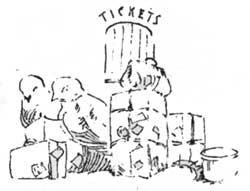

|
Good roads, bad roads, fair weather or foul, depression or prosperity; all are the same to one class of visitors upon whom the Mesa Verde may regularly depend, and no matter what conditions prevail we can always be sure of having our usual share of those travelers. Season after season, year after year, they come and go, arriving at the same time each spring, departing at the same time each fall, answering the inherent law of nature that causes them to migrate with the changing seasons. 
The urge to travel is much stronger in the birds than it is in man, for while man travels of his own free will, the birds travel because of an inborn urge that has come down to them through countless generations. At certain times of the year this urge comes upon them, and no matter what the hazards may be, they must follow this instinctive call that tells them to migrate. A few of the birds do not have this urge to travel and remain all year in the same locality; some travel only up and down a mountain side, others move only a few hundred miles, but many, in answer to this age-old call, journey thousands of miles, sometimes half-way around the world. Interesting as it is to follow the journeys being taken by the human visitors to the park, it is even more interesting to fellow the journeys of our feathered friends, and although there has been a great deal of activity and excitement with the arrival of the travel season, we have been able to learn of some of the trips planned for the summer. Also some of the early spring travlers have brought almost unbelievable tales of their winter journeys.
Of the winter birds that left us with the first breath of spring the Juncos will make the longest journeys. The Shufeldt and the Pink-sided families have decided on Canada for their summer homes, while the Slate-colored clan has gone to Alaska. The Bohemian Waxwings, who spent a few days in the park, have also departed for Canada, while the Brown-capped Rosy Finches, which spent some time along the North Rim of the Mesa Verde will summer on the high peaks of the Northern United States. The Long-crested Jays, after keeping the air ringing with their infernal gossip during the winter, have gone to the north end of the park to raise their families, where they have been joined by the Woodhouse and Pinon Jays. The Dusky Grouse have decided to make the North Rim their year around home. The Red-breasted Nuthatches, will nest as far north as the Yukon but the Pigmy Nuthatches will stop off in the northern part of the United States. The Rocky Mountain Nuthatches, one of our tamest winter birds, have decided that Mesa Verde is a good enough place to raise the children, as also have the Robins.
Among the early travelers from the Southland were the Broad-tailed Hummingbirds, who, after spending a pleasant winter among the flowers of far-away Guatemala, returned to the park on April twelfth in the midst of a blinding snowstorm. Soon the ground was covered with a six inch blanket and the Hummer family was a bit disconcerted. Deciding to stick it out they were soon rewarded with warm weather, and have since been joined by their cousins, the Rufous Hummers and the Black-chinned Hummers, who also spent the winter in Mexico and Guatemala. The Northern Violet-green swallows wintered in Guatemala and Costa Rica, and the Tree Swallows in Guatemala and Cuba. The Cliff and Barn Swallows, however, went much farther south, having spent the winter season in Argentina and Chili. The Western Yellow Warbler wintered in Panama and the Mourning Doves have just arrived from the same place, followed closely by the Western Nighthawks, whose tireless wings have brought them in from South America. Southern Mexico and Guatemala was the winter home chosen also by the Red-tail Hawk, Western Tanagers, Black-throated Gray Warblers, Western Gnatcatchers, Black-headed Grossbeaks, and the Ash-throated Flycatchers. The Swainson Hawks went on south to hunt in Argentina. The Red-naped Sapsuckers stopped over for a few days on their journey from Guatemala to Canada, and six Mallard Ducks were seen circling the catchment area but did not pause on their long trek from Panama to Alaska.
Every day new arrivals are noted and with the continued warm weather they will soon have settled down to the task of raising families. Many have already chosen their summer homes. The Golden Eagles decided not to remodel their home on the Knife Edge Cliff and are nesting elsewhere along the North Rim. A pair of Turkey Vultures have set up housekeeping in one of the back rooms of Thomas House Ruin and will soon have a pair of fluffy babies to feed. The Red-tailed hawks are again nesting in the vicinity of Sun Temple, and a number of Cooper's Hawks have been seen in that locality. A Pair of Broad-tailed Hummers are nesting on a tiny point of rock just above the long ladder on the Square Tower House trail, and the White-throated Swifts are again at the old address above Little Long House. The Robins, Rocky Mountain Nuthatches, and Chipping Sparrows are nesting in the Headquarters area. Soon the nests will be full of hungry youngsters and in an amazingly short time they will be on the wing. Then, after a short training period for the novices the flocks will begin to gather, and when the frosts of early autumn are flushing the hillsides with color the age-old urge will send the feathered hordes winging to their winter homes. -oOo- | ||||||
| <<< Previous | > Cover < | Next >>> |
vol3-1g.htm
14-Oct-2011